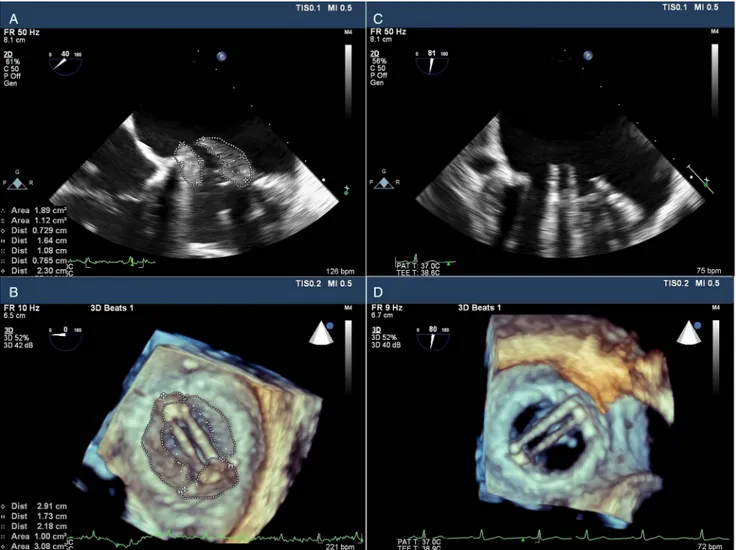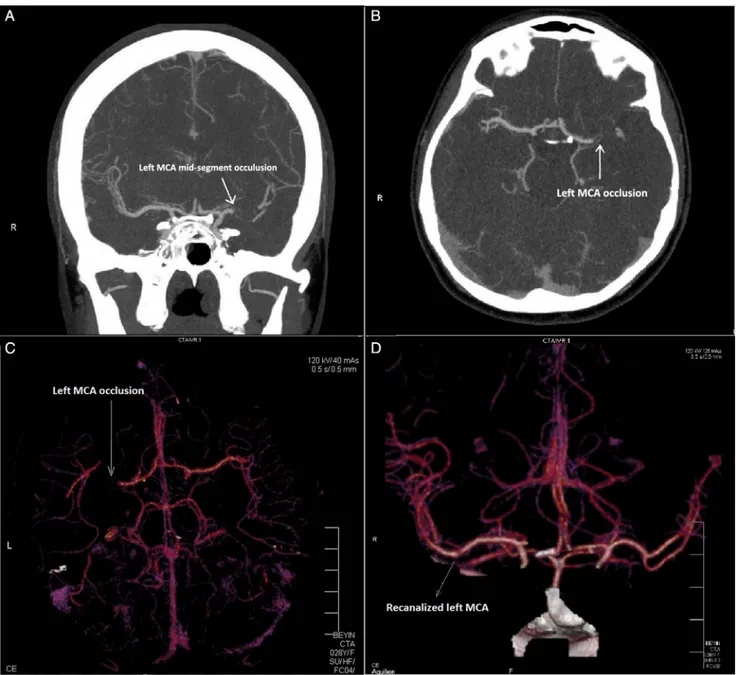Management of an acute ischemic stroke
during thrombolytic treatment in a pregnant
patient with prosthetic valve thrombosis
MACIT KALÇIK1,*, MAHMUT YESIN2, EMRAH BAYAM3, MUSTAFA OZAN GÜRSOY4,
AHMET GÜNER3, SABAHATTIN GÜNDÜZ3, MEHMET ÖZKAN3,5
1Department of Cardiology, Faculty of Medicine, Hitit University, Çorum, Turkey 2Department of Cardiology, Kars Harakani State Hospital, Kars, Turkey
3Department of Cardiology, Kosuyolu Kartal Heart Training and Research Hospital, Istanbul, Turkey 4Department of Cardiology, Gaziemir State Hospital,İzmir, Turkey
5Division of Health Sciences, Ardahan University, Ardahan, Turkey
*Corresponding author: Macit Kalçik; Department of Cardiology, Faculty of Medicine, Hitit University, Buharaevler Mah. Buhara 25. Sok. No: 1/A Daire: 22, Çorum 19000, Turkey; Phone: +90 536 4921789; Fax: +90 3645117889; E-mail: macitkalcik@yahoo.com
(Received: July 18, 2017; Revised manuscript received: July 20, 2017; Accepted: July 21, 2017)
Abstract: Prosthetic valve thrombosis (PVT) is a life-threatening complication in pregnant women with mechanical prosthetic heart valves. Thrombolytic therapy (TT) has evolved as an effective treatment alternative to surgery, which is associated with very high maternal and fetal mortality and morbidity in these patients. Acute ischemic stroke may rarely occur during TT for PVT. Here, we present a pregnant patient who was complicated with cerebral thromboembolism during TT for PVT and successfully managed with continuation of TT.
Keywords: prosthetic valve, stroke, thrombolysis, thrombus, transesophageal echocardiography
Introduction
Prosthetic valve thrombosis (PVT) is one of the major complications of mechanical prosthetic heart valve replace-ment. Pregnancy is associated with increased risk of throm-bosis among women with mechanical prosthetic heart valves [1]. Thrombolytic therapy (TT) has evolved as an effective alternative to surgery, which is associated with very high maternal and fetal mortality and morbidity in pregnant patients with PVT [2, 3]. The most feared complication during TT of left-sided PVT is cerebral thromboembolism. We present a pregnant patient who was complicated with cerebral thromboembolism during TT for PVT and successfully managed with continuation of TT.
Case Presentation
A 28-year-old woman who had undergone mitral valve replacement 8 years earlier was admitted to our hospital
with dyspnea. She was pregnant for 6 months and under anticoagulant therapy with low moleculer weight heparin for 6 months. Transthoracic echocardiography (TTE) and subsequently two-dimensional (2D) and real-time three-dimensional (RT3D) transesophageal echocardiography (TEE) were performed for the evalu-ation of prosthetic mitral valve. TTE revealed high transmitral gradients (maximum/mean: 37/23 mmHg) and decreased valve area (1.1 cm2) with normal left ventricular ejection fraction. Subsequently, 2D and RT3D TEE showed an obstructive thrombus on the mitral pros-thesis(Fig.1Aand1B). After the informed consent of the patient was taken, TT was started with a protocol of low dose (25 mg) and ultraslow infusion (25 h) of tissue-type plasminogen activator (tPA), as recently reported [3, 4]. After thefirst session of TT, TEE revealed a decrease in the thrombus burden; however, there was a mobile residual thrombus (10 mm in length) on the mitral prosthesis. Based upon these findings, a second session of TT was
This is an open-access article distributed under the terms of the Creative Commons Attribution License, which permits unrestricted use, distribution, and reproduction in any medium for non-commercial purposes, provided the original author and source are credited.
Interventional Medicine & Applied Science, Vol. 9 (3), pp. 150–153 (2017) C A S E R E P O R T
scheduled. During the second session of TT, acute stroke occurred that resulted in right hemiplegia. Cerebral multi-detector computed tomography (MDCT) angiography was urgently performed with fetal radiation protection. MDCT angiography revealed thrombotic occlusion of left middle cerebral artery (MCA) without any sign of hemor-rhage(Fig.2A–2C). After an immediate consultation with a neurologist and radiologist, TT was restarted with an accelerated rate (25 mg/2 h) of infusion. The hemiplegia was completely resolved and MDCT showed normal MCA perfusion at the end of two accelerated sessions within 4 h (Fig. 2D). Subsequently, control 2D and RT3D TEE revealed complete lysis of the thrombus on the mitral prosthesis(Fig.1Cand1D). At the end of 38th week of pregnancy, a healthy baby was delivered.
Discussion
PVT is one of the major causes of prosthetic valve dysfunc-tion. Treatment modalities for PVT include anticoagulation
with heparin, TT, and surgery. Surgery is suggested as a first-line strategy in most situations of left-sided PVT; however, multiple recent non-randomized studies have shown the efficacy and safety of low dose and slow infusion thrombolysis in patients with left-sided PVT in most patients [1–3]. Hence, the American College of Cardiolo-gy/American Heart Association Focused Update on Val-vular Heart Disease Guidelines now equally recommends (Class 1B) urgent thrombolysis or surgery for obstructive PVT asfirst-line treatment strategy [5].
Pregnancy is associated with increased risk of throm-bosis among women with mechanical prosthetic heart valves. PVT in pregnancy is a life-threatening event for both mother and fetus and treatment of this complication is unclear. Although no evidence-based guidelines for pregnant patients complicated with PVT are currently available, recommendations of guidelines for this compli-cation are similar to the management of PVT in non-pregnant patients.
We have previously reported that repeated doses of low dose (25 mg) and slow infusion (6 h) of tPA under
Fig. 1. Two-dimensional (A) and real-time three-dimensional (B) transesophageal echocardiography showed an obstructive thrombus on the mitral prosthesis on admission and complete lysis of the thrombus after thrombolytic therapy (C and D)
Acute ischemic stroke during thrombolytic therapy
the guidance of serial TEE was superior to faster infusion and/or higher dose protocols or streptokinase [1]. This protocol provided excellent results even in pregnant patients with PVT [2]. In addition, we have very recently reported that ultraslow (25 h) infusion of low dose (25 mg) tPA without bolus appears to be associated with quite low complications and mortality rates for PVT patients without compromising post-thrombolytic success [3, 4].
Cerebral thromboembolism may rarely occur during TT for PVT [6]. Thefirst 6 h after cerebral thromboem-bolism are very substantial and early diagnosis and exclu-sion of hemorrhage by MDCT is very important [7]. Acute ischemic stroke may be managed with intravenous
thrombolysis, combination of thrombolytics with other antiaggregants like glycoprotein IIb/IIIa inhibitors, intraarterial thrombolysis, and other catheter-based approaches, such as mechanical thrombectomy [8, 9]. This is the second case reported by our team emphasizing that continuation of TT with an accelerated protocol may provide a chance for successful lysis of both valvular and cerebral thrombosis for such patients who suffer acute ischemic stroke during TT.
In current case, a decision was made in favor of continuing TT on top of TT, which resulted in striking neurological improvement. The recommended tPA dose for acute ischemic stroke regarding current guidelines is 0.9 mg/kg (maximum dose 90 mg) over 60 min with
Fig. 2. Cerebral multidetector computed tomography (MDCT) angiography revealed thrombotic occlusion of left middle cerebral artery (MCA) without any sign of hemorrhage (A–C). The MCA occlusion was successfully recanalized after thrombolytic therapy (D)
Kalçık et al.
10% of the dose given as a bolus over 1 min [7]. Although the protocol we used was lower than the recommended doses for safety concerns, the success may be due to the early diagnosis and fresh nature of the thrombus. Faster TT regimens may induce new thromboembolisms in patients with concomitant PVT.
* * * Funding sources: None.
Data sharing: No additional data.
Authors’ contribution: All of the authors contributed planning, con-duct, and reporting of the work. All contributors are responsible for the overall content as guarantors.
Conflict of interest: The authors declare no conflict of interest.
References
1. Özkan M, Cakal B, Karakoyun S, Gürsoy OM, Çevik C, Kalçık M, Oğuz AE, Gündüz S, Astarcioglu MA, Aykan AÇ, Bayram Z, Biteker M, Kaynak E, Kahveci G, Duran NE, Yıldız M: Thrombolytic therapy for the treatment of prosthetic heart valve thrombosis in pregnancy with low-dose, slow infusion of tissue-type plasminogen activator. Circulation 128, 532–540 (2013)
2. Özkan M, Gunduz S, Biteker M, Astarcioglu MA, Çevik C, Kaynak E, Yıldız M, Oğuz E, Aykan AÇ, Ertürk E, Karavelioğlu Y, Gökdeniz T, Kaya H, Gürsoy OM, Çakal B, Karakoyun S, Duran N, Özdemir N: Comparison of different TEE-guided thrombolytic regimens for prosthetic valve thrombosis: The TROIA trial. JACC Cardiovasc Imaging 6, 206–216 (2013)
3. Özkan M, Gündüz S, Gürsoy MO, Karakoyun S, Astarcıoğlu MA, Kalçık M, Aykan AÇ, Çakal B, Bayram Z, Oğuz AE, Ertürk E, Yesin M, Gökdeniz T, Duran NE, Yıldız M, Esen AM: Ultra-slow
thrombolytic therapy: A novel strategy in the management of PROs-thetic MEchanical valve Thrombosis and the prEdictors of outcomE: The Ultra-slow PROMETEE Trial. Am Heart J 170, 409–418 (2015). doi:10.1016/j.ahj.2015.04.025
4. Kalçık M, Gürsoy OM, Astarcıoğlu MA, Özkan M: A serial fluoros-copy-guided thrombolytic therapy of a mechanical tricuspid pros-thetic valve thrombosis with low-dose and ultra-slow infusion of tissue-type plasminogen activator. Turk Kardiyol Dern Ars 42, 478– 481 (2014)
5. Nishimura RA, Otto CM, Bonow RO, Carabello BA, Erwin JP 3rd, Fleisher LA, Jneid H, Mack MJ, McLeod CJ, O’Gara PT, Rigolin VH, Sundt TM 3rd, Thompson A: 2017 AHA/ACC Focused Update of the 2014 AHA/ACC Guideline for the Management of Patients with Valvular Heart Disease: A report of the American College of Cardiology/American Heart Association Task Force on Clinical Practice Guidelines. Circulation 135, e1159–e1195 (2017) 6. Özkan M, Gürsoy OM, Atasoy B, Uslu Z: Management of acute ischemic stroke occurred during thrombolytic treatment of a patient with prosthetic mitral valve thrombosis: Continuing throm-bolysis on top of thromthrom-bolysis. Anadolu Kardiyol Derg 12, 689– 690 (2012)
7. Adams HP Jr, del Zoppo G, Alberts MJ, Bhatt DL, Brass L, Furlan A, Grubb RL, Higashida RT, Jauch EC, Kidwell C: Guidelines for the early management of adults with ischemic stroke: A guideline from the American Heart Association/American Stroke Association, Stroke Council, Clinical Cardiology Council, Cardiovascular Radi-ology and Intervention Council, and the Atherosclerotic Peripheral Vascular Disease and Quality of Care Outcomes in Research Inter-disciplinary Working Groups. Stroke 38, 1655–1711 (2007) 8. Hacke W, Kaste M, Fieschi C, Toni D, Lesaffre E, von Kummer
R, Boysen G, Bluhmki E, Höxter G, Mahagne M-H, Hennerici M: Intravenous thrombolysis with recombinant tissue plasmino-gen activator for acute hemispheric stroke: The European Cooperative Acute Stroke Study (ECASS). JAMA 274, 1017– 1025 (1995)
9. White CJ, Abou-Chebl A, Cates CU, Levy EI, McMullan PW, Rocha-Singh K, Weinberger JM, Wholey MH: Stroke intervention: Catheter-based therapy for acute ischemic stroke. J Am Coll Cardiol 58, 101–116 (2011)
Acute ischemic stroke during thrombolytic therapy

